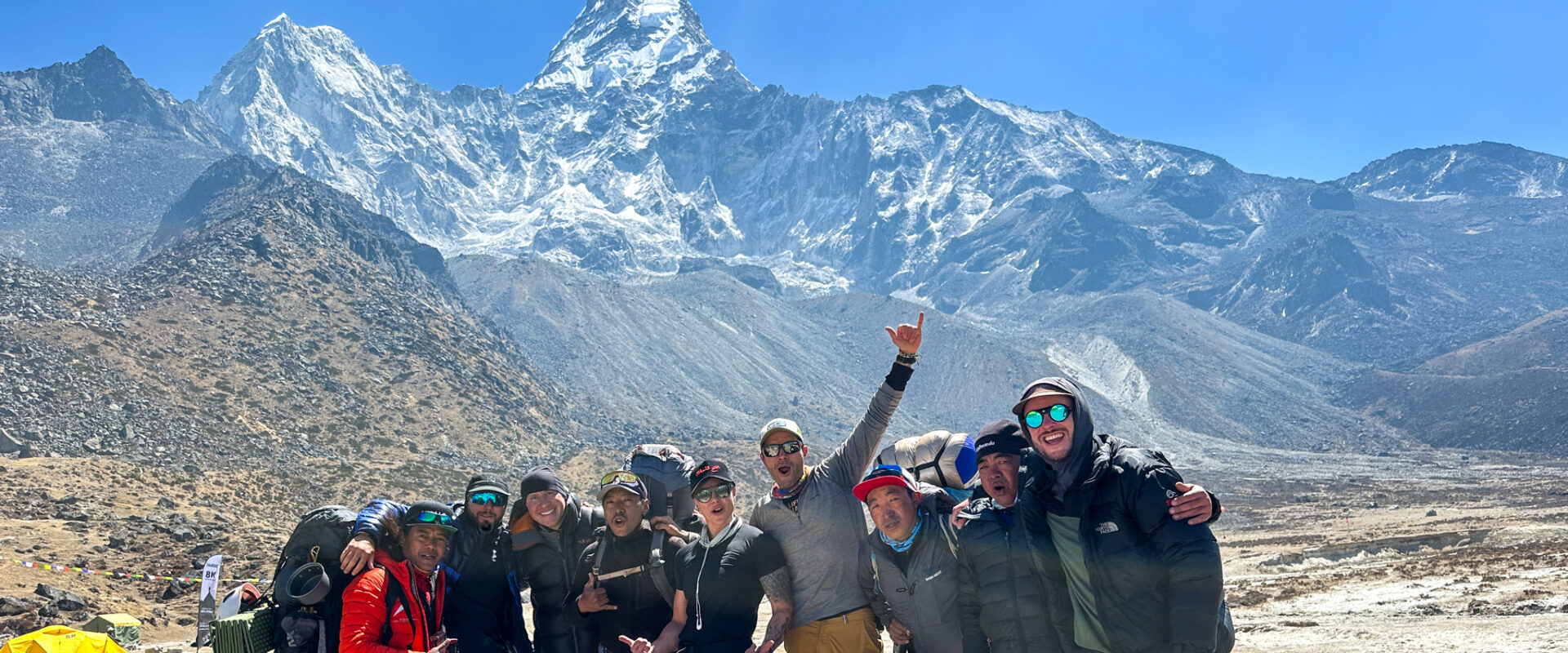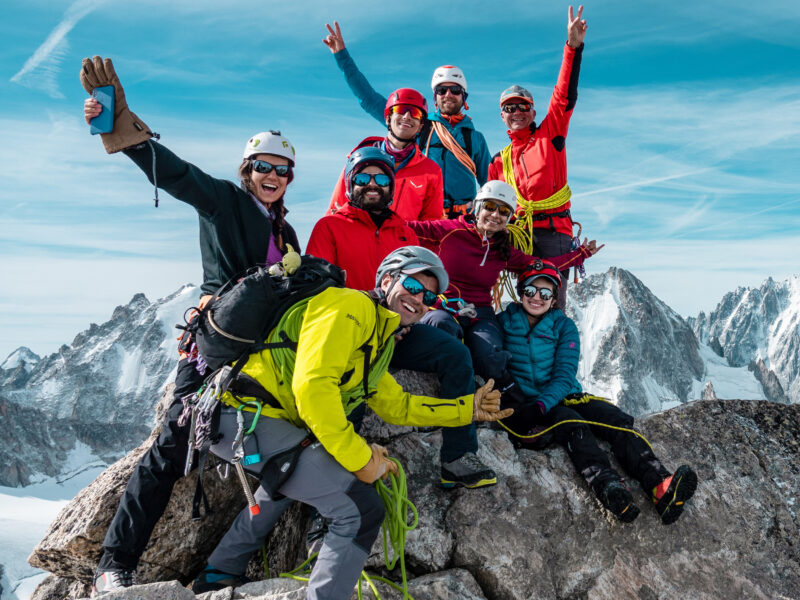BY Rami Rasamny | August 11 2025
The Ultimate Guide to Climbing Ama Dablam

Soaring to 6,812 meters (22,349 feet) in the heart of the Khumbu region of Nepal, Ama Dablam is often called the “Matterhorn of the Himalayas” for its striking pyramid shape and sheer beauty. Rising above the Sherpa villages on the way to Everest Base Camp, its name meaning “Mother’s Necklace” comes from the long ridges that drape down each side like protective arms, with a hanging glacier forming the pendant.
Ama Dablam is more than a mountain. It is a defining landmark for trekkers on the trail to Everest and a dream objective for climbers who want to test themselves on one of the most beautiful technical peaks in the world. Its combination of altitude, commitment, and sustained climbing make it an achievement that stays with you for life.
The History of Ama Dablam Climbing
The first ascent of Ama Dablam was made in 1961 by a team led by Sir Edmund Hillary’s trusted climbing partner Mike Gill, alongside Barry Bishop, Mike Ward, and Wally Romanes. They reached the summit via the now-classic Southwest Ridge, a line that has since become one of the most iconic routes in the Himalayas. In the decades since, Ama Dablam has developed a reputation as a climber’s mountain — a place where skill, preparation, and patience come together in one of the most rewarding alpine experiences on earth.
When to Climb Ama Dablam
The prime seasons for climbing Ama Dablam are pre monsoon (April to early May) and post monsoon (late September to early November). These windows offer more stable weather, colder temperatures to keep the mountain’s ice and rock stable, and clearer skies for those unforgettable Himalayan panoramas.
In recent years, post monsoon has become particularly crowded because most of the 8,000 meter peaks are closed to expeditions at that time. Many teams shift their focus to the 6,000 meter peaks, filling the trails and camps. In contrast, during the pre monsoon season, the 8,000 meter expeditions are active, drawing much of the climbing traffic away. This leaves Ama Dablam and other 6,000 meter peaks less busy, in some cases almost empty, creating a quieter and more intimate mountain experience.
How Long Does It Take to Climb Ama Dablam
A well structured Ama Dablam climbing itinerary takes around 25 to 30 days door to door, including travel, trekking to base camp, acclimatization, and the summit push.
At Life Happens Outdoors, we typically allow about two weeks from the time we leave Lukla until we stand on the summit, with several acclimatization days built in and a careful approach to route preparation. The summit push itself usually takes 4 to 6 days from base camp, with rotations to higher camps beforehand to position the team for success.
How Hard Is It to Climb Ama Dablam
Ama Dablam is widely considered one of the most technical trekking peaks in Nepal. While it does not reach the extreme altitudes of Himalayan giants like Everest or K2, it demands strong alpine skills. Climbers can expect sustained sections of steep rock, snow, and ice, as well as multiple days living and moving above 6,000 meters.
Confidence with fixed lines, efficient movement in crampons, and the ability to manage yourself in exposed positions are essential. The Southwest Ridge offers some of the best mixed climbing in the Himalayas but also no easy escape once committed. This is a mountain for those who want to blend technical climbing with high altitude expedition life.
How Much Does It Cost to Climb Ama Dablam
Costs vary depending on the expedition style, length, and level of support, but most climbers can expect to pay between:
£8,000 and £18,000 GBP
(approximately $10,200 to $22,900 USD or €9,300 to €20,900 EUR)
At Life Happens Outdoors, our Ama Dablam expedition is a full service experience that includes IFMGA certified guiding, all permits and fees, Sherpa and porter support, high quality expedition tents, all meals on the mountain, technical training sessions, and carefully planned acclimatization. This is not just a guided climb — it is a complete journey into the heart of the Khumbu, where the summit is one milestone in a much larger adventure.
How to Climb Ama Dablam
Most climbers attempt Ama Dablam via the Southwest Ridge, the same line pioneered in 1961. It is a route that is as aesthetic as it is challenging, weaving through granite towers, snow ridges, and icefields before the final push to the summit.
The climb typically follows this structure:
- Base Camp (4,570m): A comfortable, well established camp with views of the Southwest Ridge and the surrounding giants.
- Camp 1 (5,800m): Reached via steep grassy slopes and rocky ridges, requiring careful movement over mixed terrain.
- Camp 2 (6,200m): Perched on a dramatic rock platform with exposure in every direction. Access involves steep rock climbing sections on fixed lines.
- Summit Day (6,812m): From Camp 2, we make a direct push to the top, bypassing Camp 3 entirely. While some teams use Camp 3, we consider it too dangerous due to its position beneath large seracs. From Camp 2, we climb through the Dablam and onto the final snow and ice slopes to the summit.
What Do You Need to Climb Ama Dablam
Technical competence is as important as gear. You will need to be comfortable with fixed line ascents and descents, multi day high altitude exposure, and efficient rope management in alpine conditions.
Here is a basic equipment checklist for Ama Dablam:
- Double mountaineering boots warm enough for 6,800 meters
- Crampons
- Ice axes (technical or hybrid, depending on preference)
- Helmet
- Climbing harness with ascender and lanyards for fixed lines
- Down suit or high altitude down layers
- Waterproof and windproof shell layers
- Warm gloves, mitts, and liner gloves
- Glacier glasses and ski goggles
- Headlamp
- Sleeping bag rated to minus 20°C or colder
- Expedition backpack plus a smaller pack for summit day
At Life Happens Outdoors, we provide full gear advice well in advance and offer pre expedition training to ensure every climber arrives ready.
Final Thought
Climbing Ama Dablam is not just about reaching a Himalayan summit. It is about immersing yourself in the culture, landscape, and spirit of the Khumbu. It is mornings in base camp watching the sun paint Everest gold, it is moving together along an airy ridge with your team, it is pushing beyond what you thought possible.
The mountain will test you, teach you, and leave you changed. Whether or not you stand on the summit, Ama Dablam has a way of becoming part of your story — a reminder that the most beautiful journeys are the ones that challenge us to grow.
When you are ready for that journey, we will be there with you every step of the way.
About The Author
Rami Rasamny is the founder of Life Happens Outdoors, a premium adventure travel community dedicated to transforming lives through curated outdoor experiences. A mountaineer and entrepreneur, Rami has led teams on some of the world’s most challenging peaks, from the Alps to the Himalayas. His mission is to make adventure accessible, transformative, and safe for all who seek to push their limits and Come Back Different.
About Life Happens Outdoors
At Life Happens Outdoors, we believe in the power of nature to transform lives. As proud members of the Adventure Travel Trade Association (ATTA) and the World Travel & Tourism Council (WTTC), our team of certified guides and outdoor professionals is committed to the highest standards of safety, sustainability, and excellence.
Discover more about our story and mission on our Meet LHO page, or explore our curated adventures such as the Tour du Mont Blanc Trek, the Climb of Kilimanjaro, and Chasing the Northern Lights.















